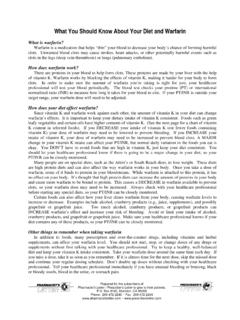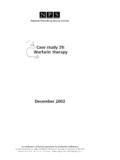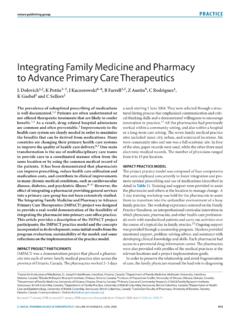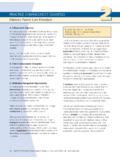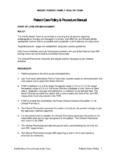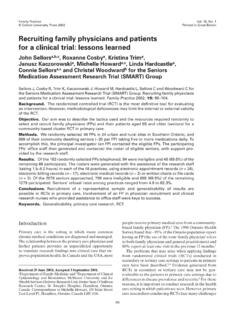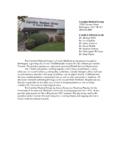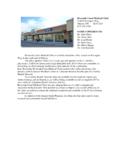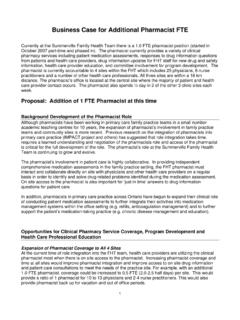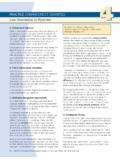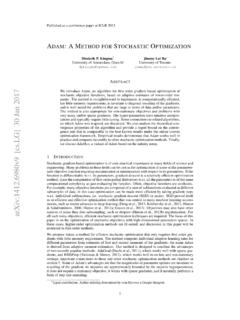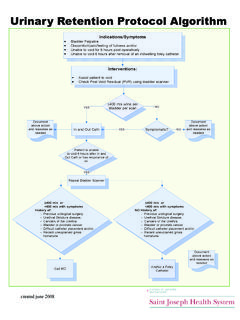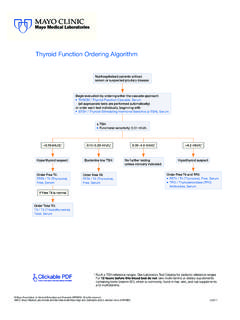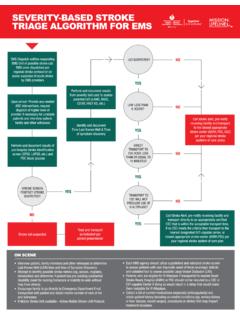Transcription of Warfarin (Coumadin ) maintenance dosing algorithm
1 Family Medicine Centre The Ottawa Hospital Family Health Team Appendix A. Warfarin (Coumadin ) maintenance dosing algorithm INR up to : Managed by nurse Goal: Goal: Note: Adjust Warfarin only if a change in INR is deemed to be permanent. Consider reloading with 1 extra dose of Warfarin . < < Increase Warfarin by 5-15%. No change. Decrease Warfarin by 5-15%. Hold 1 dose of Warfarin . Decrease Warfarin by 5-15%. Hold Warfarin until INR in therapeutic range. Decrease Warfarin by 5-15%. Consider low dose Vitamin K if high risk of bleeding (MD must be consulted and order required).
2 INR : Managed by physician Suggested management only Hold 2 doses of Warfarin OR hold 1 dose of Warfarin and give Vitamin K 1 mg orally. No increased risk Decrease Warfarin by 10-20%. of bleeding Recheck INR in 1-2 days. Increased risk Hold 1-2 doses of Warfarin . of bleeding Give Vitamin K 1 mg mg orally. or Minor bleeding Decrease Warfarin by 10-20%. Hold Warfarin . Rapid reversal required Give Vitamin K 2 mg -4 mg orally (INR should be reduced within 24 hours). (within 24 hours;. If INR remains high, give an additional dose of Vitamin K 1 mg -2 mg orally.)
3 For surgery). Restart Warfarin at lower dose once INR is within therapeutic range. Serious bleeding See below INR and above: Managed by physician Suggested management only Hold Warfarin . Give Vitamin K 3 mg -5 mg orally (INR should be reduced within 24-48 hours). and Monitor INR more frequently and repeat Vitamin K as necessary. No serious bleeding Restart Warfarin at lower dose once INR is within therapeutic range. Send the patient to ER. Consider consulting hematology. > Hold Warfarin . or Give Vitamin K 10 mg IV by slow infusion.
4 Repeat q12h as needed. Serious bleeding May require supplementation with fresh frozen plasma. In cases of life-threatening bleeding, administer prothrombin complex concentrate. Notes on Warfarin maintenance dosing algorithm Use of the algorithm This algorithm is to be used by nurses and physicians in the Family Medicine Unit. Under the terms of the medical directive, the recommendations for managing INRs up to may be followed by the nursing staff without consulting a physician. The nursing component can be instituted once a patient newly started on Warfarin has had two consecutive INRs in the therapeutic range, has been on Warfarin for at least two weeks and is deemed stable by the physician.
5 The patient's physician must be notified immediately and, in most cases, take over direct management of Warfarin dosing under the following circumstances: - the INR is or greater, - an unexpected significant change of the INR result over a patient's established level, even if it does not exceed , or - any amount of unexpected or prolonged bleeding, - any time the status of the patient changes in any way that does or may affect the anticoagulation status. The patient's physician should place the patient back on the nurses' algorithm once he/she has decided the patient's status has stabilized.
6 This must be communicated directly with the nursing staff. Note on flexibility: The dosing and INR recommendations outlined in this algorithm should be followed in most cases. Occasionally, a nurse may exercise judgment for minor deviations outside the defined INR limits. Some of the possibilities are described below. Dose adjustments Do not change the dose if a single INR result is slightly out of range ( it is neither very high nor very low). Change doses only if there is a trend toward or established lower or higher INR results.
7 Choose a lower or higher range depending on the degree of decrease or elevation, historic response of adjustments by patient, the patient's risk profile, and convenience of dosing (availability of tablets). Make adjustments based on total weekly dose. But use daily dosing (versus Mon-Fri and Sat-Sun dosing ). whenever possible. Adjustments can be made slightly below or above range ( 5-25%) to accommodate dosing convenience ( rounding of doses to nearest .25 or .5). The decision to hold one or multiple doses should be based on the degree of INR elevation, the risk or presence of bleeding, and an assessment of the cause and duration of elevated INR ( if INR will continue to increase based on change in disease or concurrent medications).
8 Repeating the INR. 4 weeks is the maximum interval for repeating the INR; it should never be ordered less frequently than this. Repeat the INR every 4 weeks for INR (target ) or (target ). There is some flexibility in when to order subsequent INRs after dose changes. Ordinarily, the INR should be rechecked in 3-14 days depending on the various factors ( how high the INR was, the extent of the dose change, the risk of bleeding, etc.). An earlier repeat should be done if there is a risk of persistent INR elevation or bleeding.
9 If a single INR is slightly out of range and it is decided not to change the Warfarin dose, the INR must be repeated in 7-10 days. Risk of bleeding Risk of clotting The Outpatient Bleeding Risk Index : There is a greater risk of clotting the following Age >65 years circumstances. This may warrant accepting a higher risk History of stroke (ever) of bleeding. History of GI bleeding (ever) - Mechanical prosthetic valve Recent MI (within previous 1 month) or - Bioprosthetic valve < 3 months Severe anemia (Hct <30%) or - DVT/PE < 12 weeks of therapy Renal insufficiency (SCr > 130 mol/l) or - Antiphospholipid syndrome or > 1 hypercoagulable state Diabetes mellitus - Atrial fibrillation + valvular heart disease, prior stroke or If none: Low risk (3% in 12 months) systemic embolism +/-12 weeks of therapy If 1-2.
10 Intermediate risk (12% in 12 months) - History of embolization on anticoagulant therapy If 3-4: High risk (48% in 12 months) - Acute MI within previous 12 weeks Other risk factors for bleeding may include: - Warfarin started within previous 1 month - Severe liver dysfunction - Uncontrolled hypertension (BP >160/90). - Change of > INR units from last INR. - Malignancy - Recent surgery - Concomitant NSAID therapy Use of Vitamin K. Vitamin K should be given orally or intravenously only; do not inject it subcutaneously or intramuscularly.
